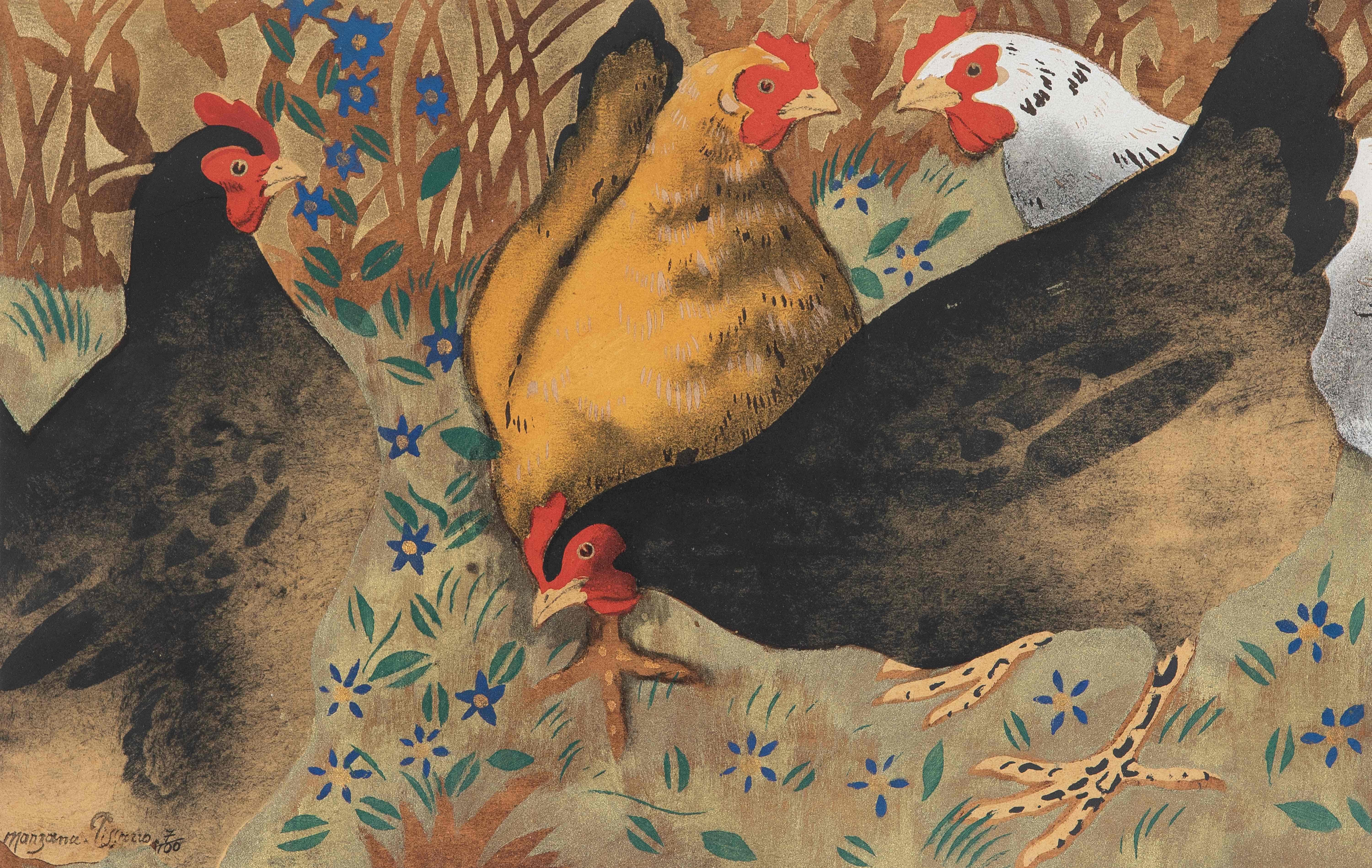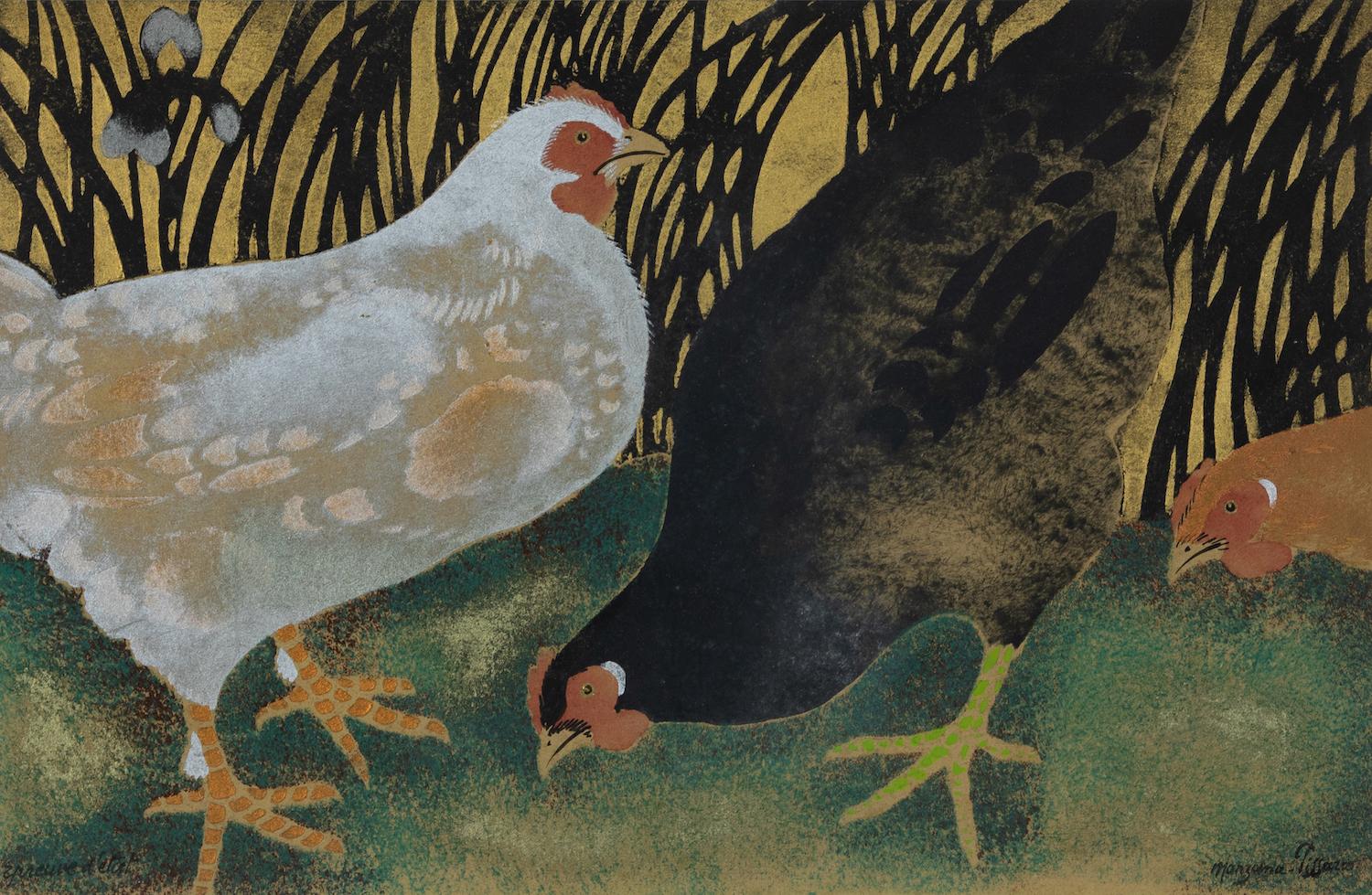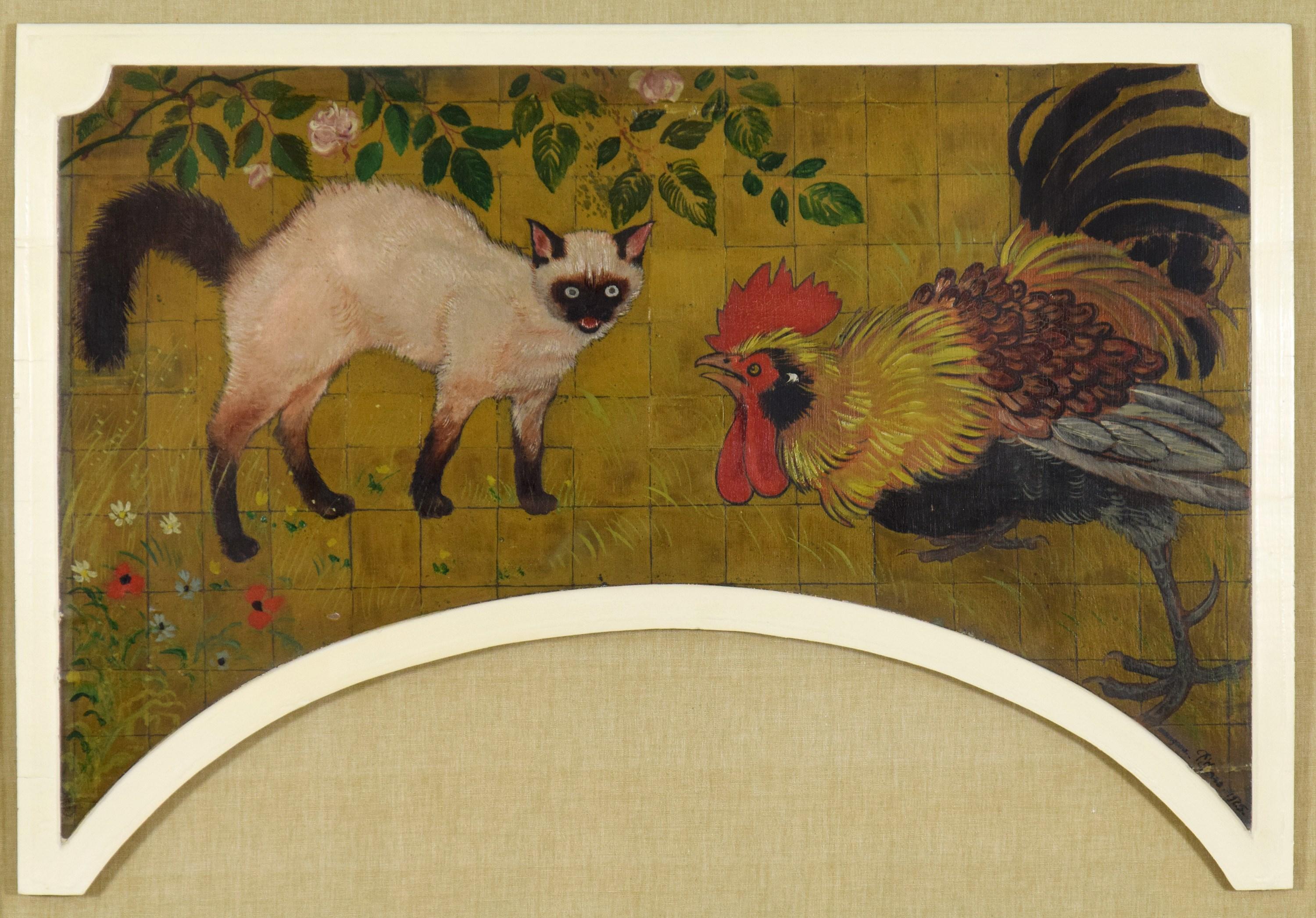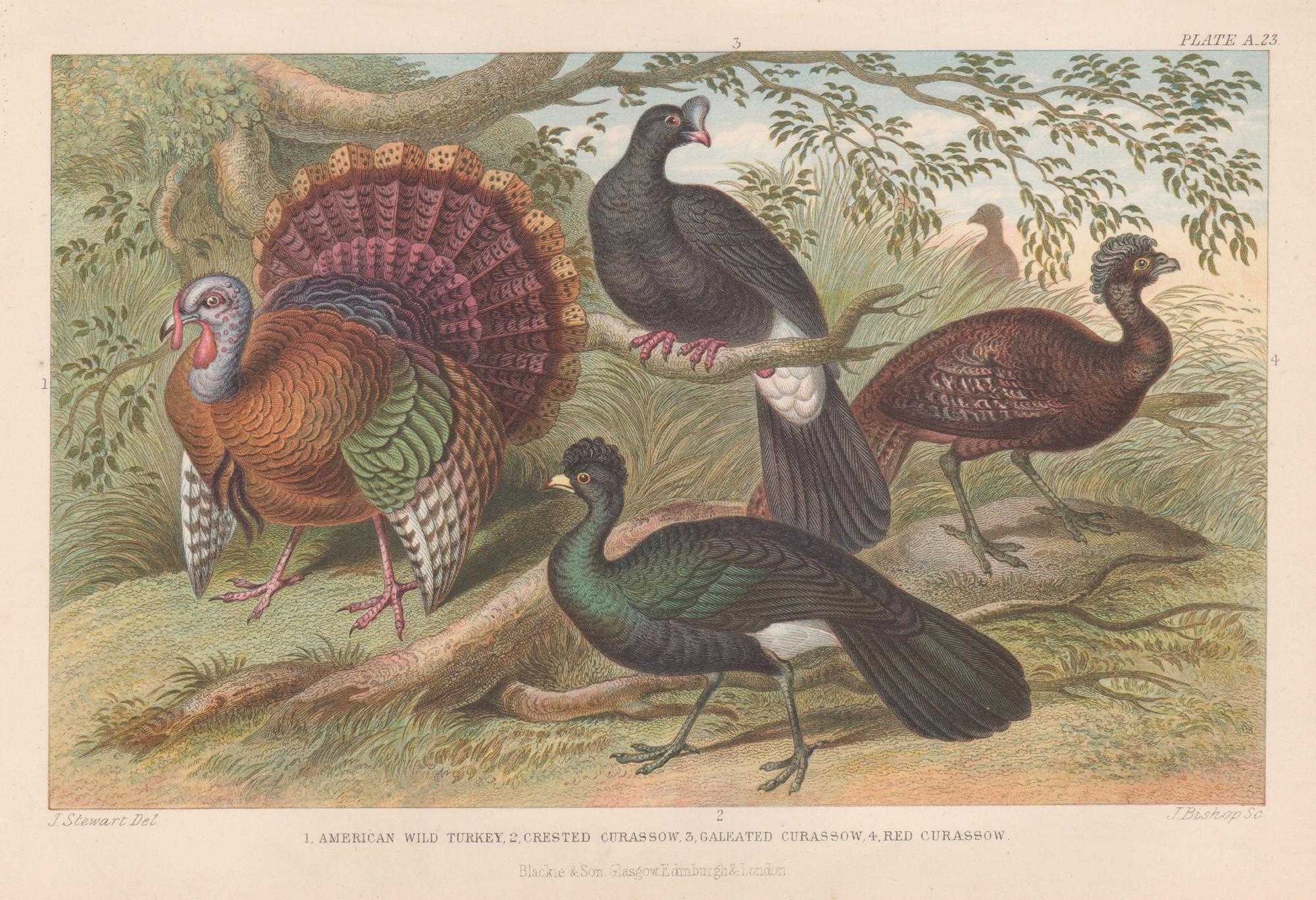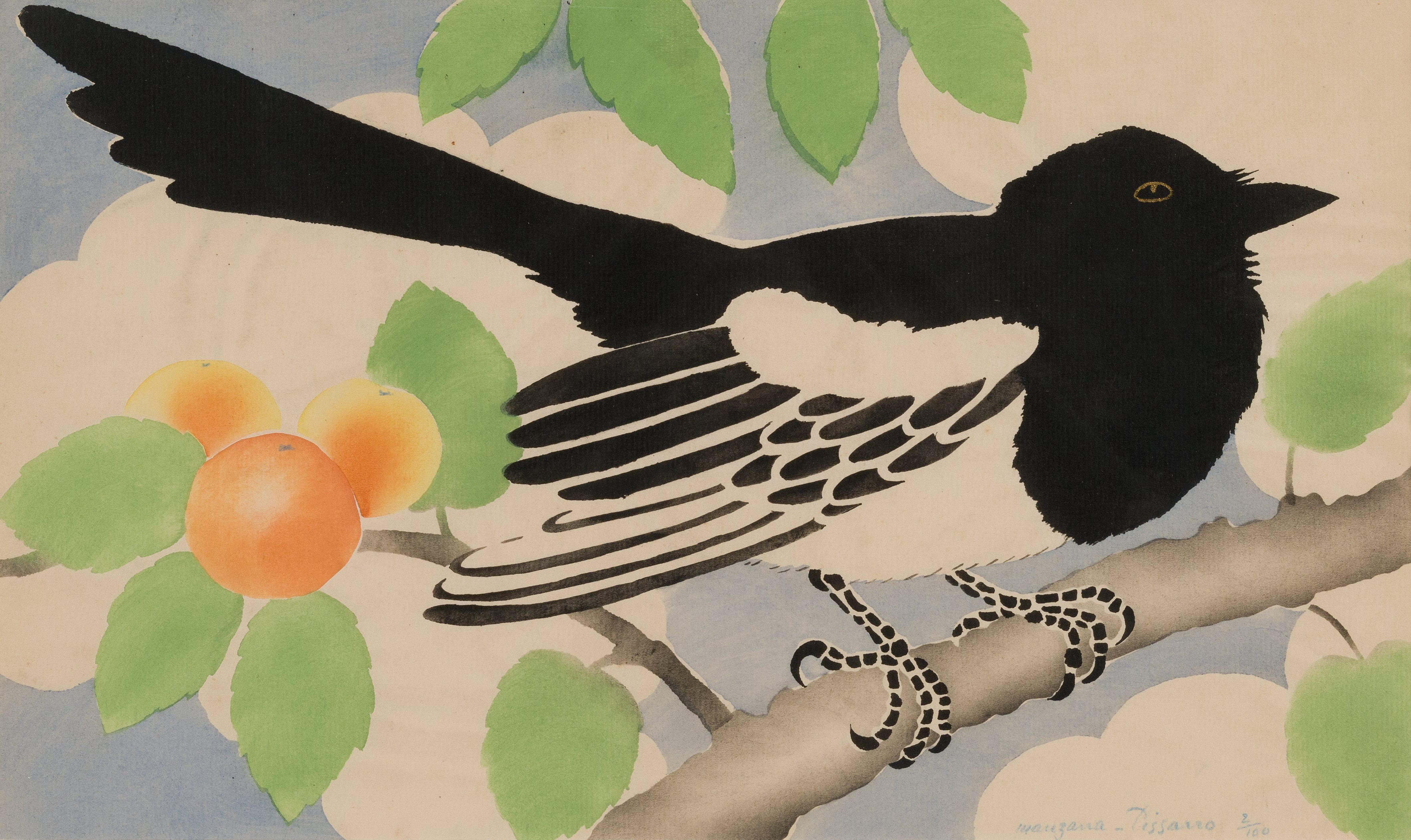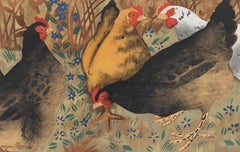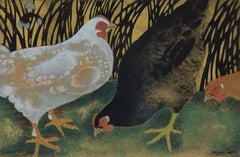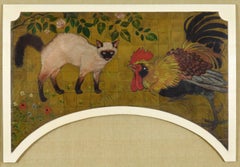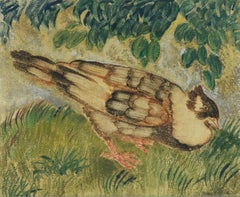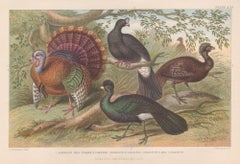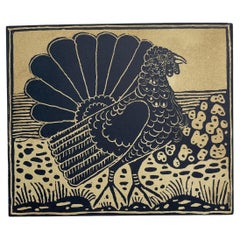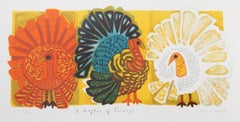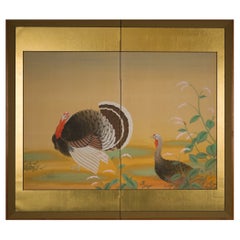Items Similar to Two Turkeys, Pochoir by Georges Manzana Pissarro
Want more images or videos?
Request additional images or videos from the seller
1 of 10
Georges Manzana PissarroTwo Turkeys, Pochoir by Georges Manzana Pissarrocirca 1920
circa 1920
$3,424.25
£2,500
€2,938.46
CA$4,727.64
A$5,241.29
CHF 2,754.50
MX$64,144.81
NOK 34,400.94
SEK 32,288.73
DKK 21,933.81
About the Item
Two Turkeys by Georges Manzana Pissarro (1871 - 1961)
Pochoir with hand-coloured metallic paint
42 x 59.5 cm (16 ½ x 23 ⅜ inches)
Signed with Estate stamp, lower left
Numbered 1/25
Created circa 1920
Provenance
Private Collection, London
Artist biography
Like all second-generation Pissarro artists, Georges Henri ‘Manzana’ Pissarro initially worked under a pseudonym. Born in 1871, Manzana was the third of Camille Pissarro’s seven children, adopting the name ‘Manzana’ in 1894 after the maiden name of his maternal grandmother. It was not until around 1910, to honour his deceased father, that he employed his family name when signing his work.
Manzana studied with his father from an early age and spent his formative years surrounded by the distinguished artists associated with the Impressionist movement – Claude Monet, Paul Cézanne, and Paul Gauguin – who frequented the Pissarro home in Éragny. At his father's side he learnt not only to handle brush and pencil but also to observe nature and its changing qualities.
Subjected to rich and diverse influences, Manzana became a prolific and versatile artist, working with oil, pastel and watercolour as well as etchings, lithography and stencils. As a young man he adopted his father's purely Impressionist style and produced a series of landscapes around Éragny. He exhibited Impressionist works at the Salon d'Automne and the Salon des Indépendants, as well as Durand Ruel and Druet galleries in Paris in the early 1900s.
In 1906 his work began to evolve. Inspired by Dr Mardus’ French translation of ‘A Thousand and One Nights’, Manzana embarked on a grand project to publish his own illustrated version of these magical tales. This pulled Manzana into the umbrella of the decorative arts movement where he flourished creating tapestries, glassware, furniture, ceramics and metal work, all inspired by Orientalism and often incorporating gold, silver and copper paint. In 1907 he had his first exhibition of decorative works at Vollard but it was the 1914 exhibition at the Musée des Arts Décoratifs in Paris which dramatically boosted his career. Here he exhibited 311 works including tapestries, carpets, furniture, glassware, decorative paintings, etchings and lithographs.
The subsequent years were filled with bright ideas, gilded costumes and a glittering lifestyle as Manzana navigated the 20s and 30s between Les Andelys and Paris, spending many summers in Brittany. These culminated in a series of colourful yet delicate new works which Manzana exhibited prolifically. When war broke out in 1939 Manzana moved with his family to Casablanca, where he remained until 1947. Manzana was married and widowed three times. The last years of his life were spent in Menton with his son Félix who was also an accomplished artist. There Manzana returned to the Impressionist tradition of his early years, painting the serene landscapes that surrounded him.
Georges Manzana Pissarro
Like all second-generation Pissarro artists, Georges Henri ‘Manzana’ Pissarro initially worked under a pseudonym. Born in 1871, Manzana was the third of Camille Pissarro’s seven children, adopting the name ‘Manzana’ in 1894 after the maiden name of his maternal grandmother. It was not until around 1910, to honour his deceased father, that he employed his family name when signing his work. Manzana studied with his father from an early age and spent his formative years surrounded by the distinguished artists associated with the Impressionist movement – Claude Monet, Paul Cézanne, and Paul Gauguin – who frequented the Pissarro home in Éragny. At his father's side he learnt not only to handle brush and pencil but also to observe nature and its changing qualities. Subjected to rich and diverse influences, Manzana became a prolific and versatile artist, working with oil, pastel and watercolour as well as etchings, lithography and stencils. As a young man he adopted his father's purely Impressionist style and produced a series of landscapes around Éragny. He exhibited Impressionist works at the Salon d'Automne and the Salon des Indépendants, as well as Durand Ruel and Druet galleries in Paris in the early 1900s. In 1906 his work began to evolve. Inspired by Dr Mardus’ French translation of ‘A Thousand and One Nights’, Manzana embarked on a grand project to publish his own illustrated version of these magical tales. This pulled Manzana into the umbrella of the decorative arts movement where he flourished creating tapestries, glassware, furniture, ceramics and metal work, all inspired by Orientalism and often incorporating gold, silver and copper paint. In 1907 he had his first exhibition of decorative works at Vollard but it was the 1914 exhibition at the Musée des Arts Décoratifs in Paris which dramatically boosted his career. Here he exhibited 311 works including tapestries, carpets, furniture, glassware, decorative paintings, etchings and lithographs. The subsequent years were filled with bright ideas, gilded costumes and a glittering lifestyle as Manzana navigated the 20s and 30s between Les Andelys and Paris, spending many summers in Brittany. These culminated in a series of colourful yet delicate new works which Manzana exhibited prolifically. When war broke out in 1939 Manzana moved with his family to Casablanca, where he remained until 1947. Manzana was married and widowed three times. The last years of his life were spent in Menton with his son Félix who was also an accomplished artist. There Manzana returned to the Impressionist tradition of his early years, painting the serene landscapes that surrounded him.
About the Seller
5.0
Recognized Seller
These prestigious sellers are industry leaders and represent the highest echelon for item quality and design.
Gold Seller
Premium sellers maintaining a 4.3+ rating and 24-hour response times
Established in 1964
1stDibs seller since 2015
104 sales on 1stDibs
Typical response time: 2 hours
Associations
Society Of London Art Dealers
- ShippingRetrieving quote...Shipping from: London, United Kingdom
- Return Policy
Authenticity Guarantee
In the unlikely event there’s an issue with an item’s authenticity, contact us within 1 year for a full refund. DetailsMoney-Back Guarantee
If your item is not as described, is damaged in transit, or does not arrive, contact us within 7 days for a full refund. Details24-Hour Cancellation
You have a 24-hour grace period in which to reconsider your purchase, with no questions asked.Vetted Professional Sellers
Our world-class sellers must adhere to strict standards for service and quality, maintaining the integrity of our listings.Price-Match Guarantee
If you find that a seller listed the same item for a lower price elsewhere, we’ll match it.Trusted Global Delivery
Our best-in-class carrier network provides specialized shipping options worldwide, including custom delivery.More From This Seller
View AllLes poules by Georges Manzana Pissarro - Stencil
By Georges Henri Manzana Pissarro
Located in London, GB
Les poules by Georges Manzana Pissarro (1871-19610
Pochoir
30 x 46 cm (11 ³/₄ x 18 ¹/₈ inches)
Signed with Estate stamp Manzana Pissarro and numbered 7/100 lower left
Artist biograp...
Category
20th Century Animal Prints
Materials
Stencil
Three Hens by Georges Manzana Pissarro - Animal stencil
By Georges Henri Manzana Pissarro
Located in London, GB
Three Hens by Georges Manzana Pissarro (1871-1961)
Pochoir
31.8 x 48.3 cm (12 ½ x 19 inches)
Signed with Estate stamp and épreuve d'état
Provenance
Private Collection, London
Artis...
Category
19th Century Post-Impressionist Animal Prints
Materials
Stencil
Cat and Cockerel, Oil and Gold on Panel by Georges Manzana Pissarro, 1925
By Georges Manzana Pissarro
Located in London, GB
Cat and Cockerel by Georges Manzana Pissarro (1871 - 1961)
Oil and gold on panel
65 x 94 cm (25 ⁵/₈ x 37 inches)
Signed and dated, Manzana Pissarro 1925
This work is accompanied by ...
Category
1920s Art Deco Animal Paintings
Materials
Gold
Procede by Georges Manzana Pissarro - Monotype of a bird, Animal
By Georges Henri Manzana Pissarro
Located in London, GB
Procede by Georges Manzana Pissarro (1871-1961)
Coloured monotype with gold, silver and pencil
24 x 30 cm (9¹/₂ x 11³/₄ inches)
Signed lower right, Manzana
Artist biogaphy
Like all ...
Category
1920s Post-Impressionist Animal Prints
Materials
Gold, Silver
Magpie by Georges Manzana Pissarro - Stencil art, Animal
By Georges Henri Manzana Pissarro
Located in London, GB
Magpie by Georges Manzana Pissarro (1871-1961)
Pochoir
26.5 x 45 cm (10 ³/₈ x 17 ³/₄ inches)
Signed lower right manzana - Pissarro and numbered 2/100
Artist biograpraphy:
Like all s...
Category
1920s Animal Prints
Materials
Stencil
Singing Rooster, Colour Crayon and Pencil on Paper by Georges Manzana Pissarro
By Georges Manzana Pissarro
Located in London, GB
SOLD UNFRAMED
Singing Rooster by Georges Manzana Pissarro (1871 - 1961)
Colour crayon and pencil on paper
22 x 16 cm (8 ⅝ x 6 ¼ inches)
This work is accompanied by a certificate of...
Category
1920s Art Deco Drawings and Watercolor Paintings
Materials
Paper, Pencil
You May Also Like
American Wild Turkey and Curassows, English antique bird engraving print, 1879
Located in Melbourne, Victoria
American Wild Turkey and Curassows
Wood-engraving with original colouring. 1879.
160mm by 245mm (sheet).
Key below the image. From Oliver Goldsmith's 'A History of the Earth and...
Category
Late 19th Century Victorian Animal Prints
Materials
Engraving
François-Xavier Lalanne (1927-2008) Le Dindon (the turkey)
By François-Xavier Lalanne
Located in Saint ouen, FR
François-Xavier Lalanne (1927-2008) La chèvre (the goat), 2004
Original print (etching on paper) hand signed in pencil by François Xavier Lalanne and untitled "La Chèvre" ("The Goat"...
Category
Early 2000s French Modern Prints
Materials
Paper
$1,236 Sale Price
20% Off
A Rafter of Turkeys, Lithograph by Judith Bledsoe
By Judith Bledsoe
Located in Long Island City, NY
Judith Bledsoe, American (1938 - 2013) - A Rafter of Turkeys. Year: circa 1974, Medium: Lithograph, signed and numbered in pencil, Edition: EA 34/60, Image Size: 8.5 x 13 inches, Si...
Category
1970s Folk Art Prints and Multiples
Materials
Lithograph
Japanese Two Panel Screen, Turkeys
Located in Hudson, NY
Mineral pigments on silk, mounted on a gold panel, in silk border. Signature and seal read: Yoho.
Category
Early 20th Century Japanese Paintings and Screens
Materials
Silk
Pair of Chickens, 10x12" oil on board
By Lu Haskew
Located in Loveland, CO
Pair of Chickens by Lu Haskew
Oil 10x12" image size
This painting is unframed, canvas on gator board, the price reflects that it is unframed.
Shipping price includes the custom pac...
Category
Early 2000s American Impressionist Paintings
Materials
Oil
$400 Sale Price
20% Off
Turkeys - Animal Oil Painting Colors Yellow Green Brown Blue White Red Pink
By Stanislav Gedzevich
Located in Sofia, BG
"Turkeys " is an oil painting by the impressionist Maestro Stanislav Gedzevich.
About the artwork:
TECHNIQUE: oil painting
STYLE: Impressionist, Contemporary
Edition : Unique, sig...
Category
2010s Impressionist Animal Paintings
Materials
Canvas, Oil
More Ways To Browse
Antique Furniture Stencils
Turkish Costumes
Antique Umbrella Gold
Antique Turkish Copper
Antique Metal Stencils
Poster Ville Vintage
Punk Rock Posters
Robert Indiana 1996
Spa Poster
Starry Starry Night Vintage
Tarot Cards
Wren Print
Belgian Film Posters
E Cooke
Isadora Duncan
Jose Oliver
Kaws Lithograph
Les Grands Boulevards
